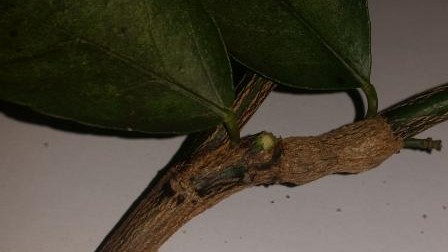Hello, I’m Citrus Gall Wasp
ALIASES
No aliases but my proper name is Bruchophagus fellis.
DESCRIBE YOURSELF
I am tiny, less than 3 mm in length. You will rarely see me, as I am a poor flyer and tend to get blown from tree to tree. You will, however, see my home. I’m known as citrus gall wasp cause I create a gall in the stems of citrus trees, where I lay my eggs.
KNOWN ASSOCIATES
No known associates, me and my babies make your plants look ugly enough on our own.
WHERE DO I HANG OUT
I love grapefruit, oranges, lemon and lime trees. I really love native finger limes as this was where I started my campaign from.
HOW DO YOU KNOW IF YOU’VE BEEN MUGGED BY CITRUS GALL WASP
The first sign most gardeners notice is ugly bumps or galls on the stems of their citrus trees. These galls are formed by the trees in response to the presence of my young who are feeding. Once they appear, the galls cannot be ‘cured’ or reversed. Old galls are ugly, but they are also empty as the adult wasp has left through the tiny exit holes. Developing galls can be removed but this can mean the loss of new fruit growing at the end of the infected stem. Citrus gall is more damaging to younger citrus trees than older trees.
MODUS OPERANDI
The adult wasps mate in spring and the female lays her eggs in the citrus tree that she herself emerged from just days before. Each female can lay up to 100 eggs, usually under the bark of new shoots, and the larvae hatch after 2 to 4 weeks. The wasp larvae grow within the soft stem tissue for 9 to 12 months until they emerge as adult wasps the following year. The larvae can be already present in newly purchased citrus trees in spring.
HOW DO YOU MAKE ME FEEL UNWELCOME
At the moment it’s not easy to make me feel unwanted. The best way is to remove new galls before I hatch and therefore interrupt my lifecycle. However, unless you do this early on you could lose a lot of good fruit and, although unsightly, I am unlikely to kill your tree. The best deterrent is to attract good bugs into your garden (Good Bugs in your garden #1). Otherwise you can spray citrus leaves with organic pest oil as I hate landing on the sticky surface, so will look for another tree elsewhere. Please don’t hanging yellow sticky traps inside infected trees. The yellow is an attractant and the sticky traps are impossible for the wasp to escape, but these traps capture more beneficial insects like bees and hover flies than they catch citrus gall wasps.


